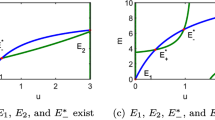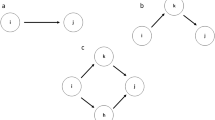Summary
We have investigated the theoretical consequences of character evolution for the population dynamics of a host—parasitoid interaction, assuming a monophagous parasitoid. In the purely ecological model it is assumed that hosts can escape parasitism by being in absolute refuges. A striking property of this model is a threshold effect in control of the host by the parasitoid, when host density dependence is weak. The approximate criteria for the parasitoid to regulate the host to low densities are (1) that the parasitoid's maximum population growth rate should exceed the host's and (2) that the maximum growth rate of the host in the refuge should be less than unity. We then use this ecological framework as a basis for a model which considers evolutionary changes in quantitative characters influencing the size of the absolute refuge. For each species, an increase in its refuge-determining character comes at a cost to maximum population growth rate. We show that refuge evolution can substantially alter the population dynamics of the purely ecological model, resulting in a number of emergent and sometimes counter-intuitive properties. In general, when the host has a high carrying capacity, systems are polarized either with low or minor refuge and ‘top-down’ control of the host by the parasitoid or with a refuge and ‘bottom-up’ control of the host by a combination of its own density dependence and the parasitoid. A particularly tantalizing result is that co-evolutionary dynamics can modify ecologically unstable systems into ones which are either stable or quasi-stable (with bouts of unstable dynamics, punctuating long-term periods of quasi-stable behaviour). We present five quantitative criteria which must all be met for the parasitoid to be the agent responsible for control of the host at a co-evolutionary equilibrium. The apparent stringency of this full set of requirements supports the empirically-based suggestion that monophagous parasitoid-driven systems should be less common in nature than those driven by multiple forms of density dependence. Further, we apply our theory to the question of whether exploiters may ‘harvest’ their victims at maximum sustainable yields and to the evolutionary stability of biological control. Finally, we present a series of testable predictions of our theory and methods useful for testing them.
Similar content being viewed by others
References
Abrams, P.A. (1986) Adaptive responses of predators to prey and prey to predators: the failure of the armsrace analogy.Evolution 40 1229–47.
Ayal, Y. (1987) The foraging strategy ofDiaeretiella rapae. I. The concept of the elementary unit of foraging.J. Anim. Ecol. 56 1057–68.
Bailey, V.A., Nicholson, A.J. and Williams, E.J. (1962) Interactions between hosts and parasites when some individuals are more difficult to find than others.J. Theor. Biol. 3 1–18.
Beddington, J.R. and Hammond, P.S. (1977) On the dynamics of host—parasite—hyperparasite interactions.J. Anim. Ecol. 46 811–21.
Beddington, J.R., Free, C.A. and Lawton, J.H. (1975) Dynamic complexity in predator—prey models framed in difference equations.Nature 225 58–60
Beddington, J.R., Free, C.A. and Lawton, J.H. (1978) Modelling biological control: on the characteristics of successful natural enemies.Nature 273, 513–19.
Briggs, C.J. (1993) Competition among parasitoid species on a stage-structured host and its effect on host suppression.Am. Nat. 141 372–97.
Chesson, P.L. and Murdoch, W.W. (1986) Aggregation of risk: relationships among host—parasitoid models.Am. Nat. 127 696–715.
Comins, H.N., Hassell, M.P. and May, R.M. (1992) The spatial dynamics of host—parasitoid systems.J. Anim. Ecol. 61 735–48.
Ford, E.B. (1975)Ecological Genetics, 4th edn. Chapman & Hall, London.
Frank, S.A. (1994) Coevolutionary genetics of hosts and parasites with quantitative inheritance.Evol. Ecol. 8 74–94.
Futuyma, D.J. (1979)Evolutionary Biology. Sinauer, Sunderland, MA.
Gauld, I. and Bolton, B. (1988)The Hymenoptera. British Museum of Natural History and Oxford University Press, London and Oxford.
Godfray, H.C.J. (1994)Parasitoids: Behavioral and Evolutionary Ecology. Princeton University Press, Princeton, NJ.
Godfray, H.C.J. and Hassell, M.P. (1991) Encapsulation and host—parasitoid population biology. InParasite—Host Associations (C.A. Toft, A. Aeschlimann and L. Bolis, eds), pp. 131–47. Oxford University Press, Oxford.
Gomulkiewicz, R. and Holt, R.D. (In press) When does natural selection prevent extinction?Evolution.
Hairston, N.G., Smith, F.E. and Slobodkin, L.E. (1960) Community structure, population control, and competition.Am. Nat. 127 696–715.
Hassell, M.P. (1975) Density-dependence in single-species populations.J. Anim. Ecol. 44 283–95.
Hassell, M.P. (1978)The Dynamics of Arthropod Predator—Prey Systems. Princeton University Press, Princeton, N.J.
Hassell, M.P. (1980) Foraging strategies, population models and biological control: a case study.J. Anim. Ecol. 49 603–28.
Hassell, M.P. and May, R.M. (1973) Stability in insect host—parasite models.J. Anim. Ecol. 42 693–726.
Hassell, M.P. and May, R.M. (1985) From individual behaviour to population dyanamics. InBehavioural ecology (R.M. Sibly and R.H. Smith, eds), pp. 3–32. Blackwell Scientific Publications, Oxford.
Hassell, M.P. and May, R.M. (1986) Generalist and specialist natural enemies in insect predator—prey interactions.J. Anim. Ecol. 55, 923–40.
Hassell, M.P. and Pacala, S.W. (1990) Heterogeneity and the dynamics of host—parasitoid interactions.Phil. Trans. R. Soc. Lond. B 330 203–20.
Hassell, M.P. and Southwood, T.R.S. (1978) Foraging strategies of insects.Ann. Rev. Ecol. System. 9 75–95.
Hawkins, B.A. (1992) Parasitoid—host food webs and donor control.Oikos 65 159–62.
Hawkins, B.A. (1993) Refuges, host population dynamics and the genesis of parasitoid diversity. InHymenoptera and biodiversity (J. LaSalle and I.D. Gauld, eds), pp. 235–56. CAB International Press, Wallingford.
Hawkins, B.A., Browning, H.W. and Smith, J.W. (1987) Field evaluation ofAllorhogas pyralophagus [Hym.: Braconidae], imported into Texas for biological control of the stalkborerEoreuma loftini [Lep.: Pyralidae] in sugarcane.Entomophaga 32 483–91.
Hawkins, B.A., Thomas, M. and Hochberg, M.E. (1993) Refuge theory and classical biological control.Science 262 1429–32.
Hochberg, M.E. and Hawkins, B.A. (1992) Refuges as a predictor of parasitoid diversity.Science 255 973–6.
Hochberg, M.E. and Hawkins, B.A. (1993) Predicting parasitoid species richness.Am. Nat. 142 671–93.
Hochberg, M.E. and Hawkins, B.A. (1994) Host refuges as predictors of parasitoid species richness and biological control. InParasitoid community ecology 451–71 (B.A. Hawkins and W. Sheehan, eds). Oxford University Press, Oxford.
Hochberg, M.E. and Lawton, J.H. (1990) Spatial heterogeneities in parasitism and population dynamics.Oikos 59 9–14.
Hochberg, M.E., Hassell, M.P. and May, R.M. (1990) The dynamics of host—parasitoid—pathogen interactions.Am. Nat. 135 74–94.
Holt, R.D. (1977) Predation, apparent competition and the structure of prey communities.Theor. Pop. Biol. 12 197–229.
Holt, R.D. and Hassell, M.P. (1993) Environmental heterogeneity and the stability of host-parasitoid interactions.J. Anim. Ecol. 62 89–100.
Holt, R.D. and Lawton, J.H. (1993) Apparent competition and enemy-free space in insect host—parasitoid communities.Am. Nat. 142 623–45.
Kakehashi, N., Suzuki, Y. and Iwasa, Y. (1984) Niche overlap of parasitoids in host—parasitoid systems: its consequence to single versus multiple introduction controversy in biological control.J. Appl. Ecol. 21 115–31.
Lande, R. (1976) Natural selection and random genetic drift in phenotypic evolution.Evolution 30 314–34.
Lawton, J.H. and McNeill, S. (1979) Between the devil and the deep blue sea: on the problems being a herbivore. InPopulation dynamics (R.M. Anderson, B.D. Turner and L.R. Taylor, eds), pp. 223–44. Blackwell Scientific Publications, Oxford.
Lewontin, R.C. (ed.) (1968),Population Biology and Evolution. Syracuse University Press, Syracuse, NY.
Manly, B.F.J. (1990)Stage-structured Populations. Chapman & Hall, London.
Marrow, P. and Cannings, C. (1993) Evolutionary instability in predator—prey systems.J. Theor. Biol. 160 135–50.
Matson, P.A. and Hunter, M.D. (1992) The relative contributions of top-down and bottom-up forces in population and community ecology.Ecology 73 723.
May, R.M. (1976) Models for single populations. InTheoretical ecology: principles and applications (R.M. May, ed.), pp. 4–25. Blackwell Scientific Publications, Oxford.
May, R.M. (1978) Host—parasitoid systems in patchy environments: a phenomenological model.J. Anim. Ecol. 47 833–43.
May, R.M. and Hassell, M.P. (1981) The dynamics of multiparasitoid—host interactions.Am. Nat. 117 234–61.
May, R.M., Hassell, M.P., Anderson, R.M. and Tonkyn, D.W. (1981) Density dependence in host—parasitoid models.J. Anim. Ecol. 50 855–65.
Murdoch, W.W. and Oaten, A. (1975) Predation and population stability.Adv. Ecol. Res. 9 2–131.
Murdoch, W.W., Luck, R.F., Walde, S.J., Reeve, J.D. and Yu, D.S. (1989) A refuge for red scale under control byAphytis: structural aspects.Ecology 70 1707–14.
Perry, J.N. and Taylor, L.R. (1986) Stability of real interacting populations in space and time: implications, alternatives and the negative binomialk c.J. Anim. Ecol. 55 1053–68.
Pimentel, D. (1961) Animal population regulation by the genetic feed-back mechanism.Am. Nat. 95 65–79.
Pimm, S.L. (1978)Food Webs. Chapman & Hall, London.
Rand, D.A., Wilson, H.B. and McGlad, J.M. (1994) Dynamics and evolution: evolutionary stable attractors, invasion exponents and phenotype dynamics.Phil. Trans. R. Soc. Lond. B 343, 261–83.
Rosenzweig, M.L. (1973) Evolution of the predator isocline.Evolution 27 84–94.
Rosenzweig, M.L. and MacArthur, R.H. (1963) Graphical representation and stability conditions of predator—prey interactions.Am. Nat. 97 209–23.
Rosenzweig, M.L., Brown, J. and Vincent, T. (1987) Red queens and ESS: coevolution and evolutionary rates.Evol. Ecol. 1 59–96.
Roughgarden, J. (1979)Theory of Population Genetics and Evolutionary Ecology: An Introduction. MacMillan Publishers, New York.
Saloniemi, I. (1993) A coevolutionary predator—prey model with quantitative characters.Am. Nat. 141 880–96.
Schaffer, W.M. and Rosenzweig, M.L. (1978) Homage to the red queen. I. Coevolution of predators and their victims.Theor. Pop. Biol. 14 135–57.
Sih, A. (1987) Prey refuges and predator—prey stability.Theor. Pop. Biol. 31 1–12.
Slobodkin, L.B. (1972) On the inconsistency of ecological efficiency and the form of ecological theories.Trans. Conn. Acad. Sci. 44 291–306.
Slobodkin, L.B. (1974) Prudent predation does not require group selection.Am. Nat. 108 665–78.
Tilman, D. (1982)Resource Competition and Community Structure. Princeton University Press, Princeton, NJ.
Turelli, M. and Barton, N.H. (1994) Genetic and statistical analysis of strong selection in polygenic traits: What, me normal?Genetics 138 913–47.
van Baalen, M. and Sabelis, M.W. (1993) Coevolution of patch selection strategies of predator and prey and the consequences for ecological stability.Am. Nat. 142 646–70.
van Driesche, R.G., Bellows, T.S., Jr., Elkinton, J.S., Gould, J.R. and Ferro, D.N. (1991) The meaning of percentage parasitism revisited: solutions to the problem of accurately estimating total losses from parasitism.Environ. Entomol. 20 1–7.
Waage, J.K. (1979) Foraging for patchily-distributed hosts by the parasitoidNemeritis canescens.J. Anim. Ecol. 48 353–71.
Author information
Authors and Affiliations
Rights and permissions
About this article
Cite this article
Hochberg, M.E., Holt, R.D. Refuge evolution and the population dynamics of coupled host—parasitoid associations. Evol Ecol 9, 633–661 (1995). https://doi.org/10.1007/BF01237660
Issue Date:
DOI: https://doi.org/10.1007/BF01237660




